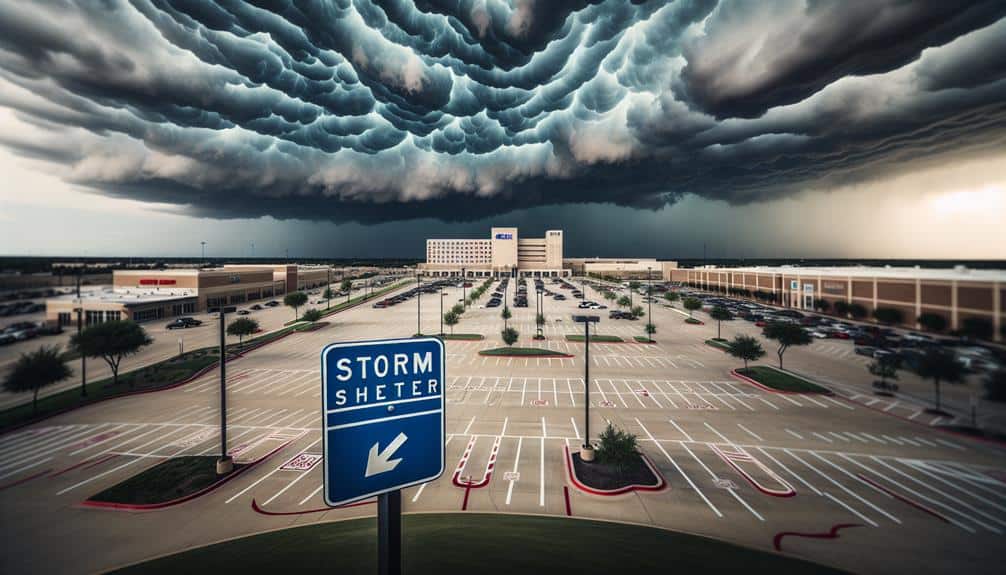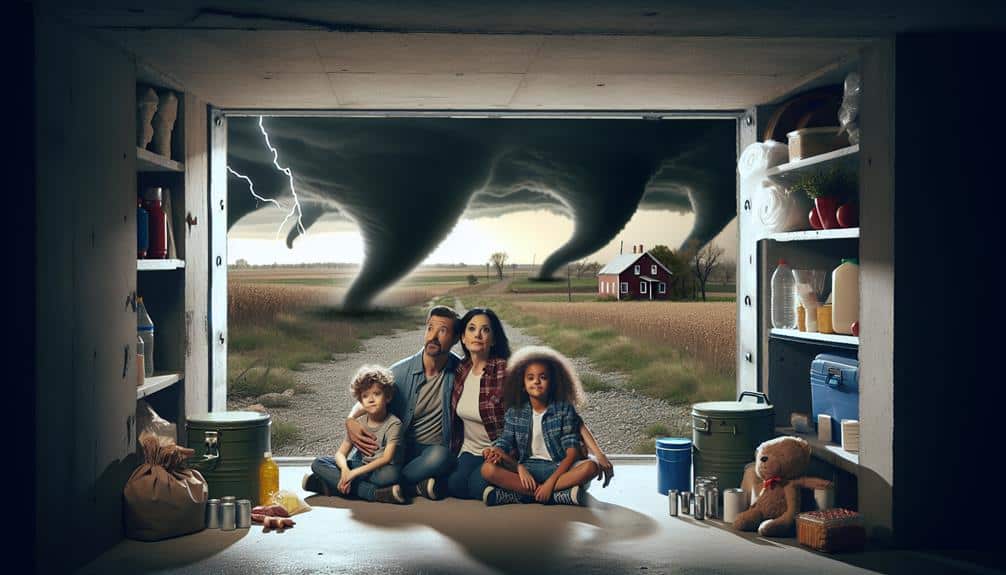We've identified the top storm shelter locations close to hospitals, focusing on structural strength and accessibility. Municipal building basements, local gathering places, and educational institution sports facilities are central and sturdy options. Subterranean parking garages provide fortified structures and clear signs. Versatile venues and college grounds can swiftly transform and work together with healthcare facilities. Civic libraries and leisure centers provide robust infrastructure and accessibility. Emergency facilities equipped with medical supplies guarantee prompt care. Each selected location highlights safety and closeness to healthcare. To delve deeper, let's examine some particular instances and specifics of these tactical selections.
Key Points
- City Hall Basement offers reinforced structure and quick accessibility.
- Community Centers provide central locations and facilities for large gatherings.
- School Gymnasiums have spacious interiors and established emergency procedures.
- Underground Parking Garages ensure structural reinforcement and proximity to hospitals.
City Hall Basement
The City Hall basement serves as an accessible storm shelter due to its reinforced structure and proximity to local hospitals. This location prioritizes our community's safety by incorporating robust safety measures. The building's reinforced concrete walls and ceilings provide a secure environment capable of withstanding severe weather conditions. Additionally, its accessibility ensures that even those with limited mobility can reach the shelter quickly.
Our emergency protocols are meticulously designed to guarantee efficiency and order during a crisis. Upon arrival, individuals are directed to designated areas within the basement, minimizing chaos and enhancing overall safety. The shelter is equipped with essential supplies, such as water, first aid kits, and communication devices, ensuring that we can sustain ourselves during prolonged emergencies.
Being near local hospitals adds an important layer of security. In the event of injuries or medical emergencies, swift access to professional medical care is available. This proximity reduces the time it takes to transport individuals to hospitals, potentially saving lives.
In essence, the City Hall basement's combination of rigorous safety measures and well-coordinated emergency protocols makes it a valuable asset for storm preparedness, embodying our community's commitment to safety and resilience.
Community Centers
Community centers offer another viable option for storm shelters, leveraging their central positions and community-focused resources for effective emergency response. Positioned within residential neighborhoods, these centers are easily accessible, guaranteeing that residents don't have to travel far during emergencies. Their proximity to hospitals adds an extra layer of safety, facilitating a seamless shift if medical attention is needed.
Community involvement plays a pivotal role here. Local churches often collaborate with community centers to provide additional resources and support during crises. This network bolsters our collective emergency preparedness, creating resilient neighborhoods.
Consider the following benefits of using community centers as storm shelters:
- Central Positions: Most community centers are strategically situated, making them an accessible refuge point.
- Established Infrastructure: These centers are equipped with facilities that support large gatherings, including restrooms and kitchens.
- Community Support: Collaboration with local churches enhances the resource pool, offering emotional and logistical support.
- Adaptive Spaces: The design of community centers allows for flexible use, capable of accommodating various emergency needs.
School Gymnasiums
School gymnasiums offer a robust option for storm shelters due to their spacious interiors and structural integrity. Typically designed to accommodate large groups, these facilities guarantee that many individuals can be sheltered simultaneously. The open layout minimizes the risk of injury from falling debris, a significant advantage during severe weather events.
From a safety measures perspective, gymnasiums often adhere to stringent building codes, making them more resilient to high winds and heavy rain. The reinforced walls and roofs, combined with limited windows, reduce vulnerabilities. This structural integrity is essential for maintaining a secure environment during a storm.
Emergency protocols also play a crucial role in utilizing school gymnasiums as storm shelters. Most schools already have well-established emergency procedures that can be activated during a storm. These protocols often include designated areas for assembling, communication plans, and stocked emergency supplies. Additionally, the familiarity of school staff with these protocols can expedite the process of getting people to safety efficiently.
Furthermore, the location of many schools in close proximity to hospitals ensures quick access to medical care if needed. By leveraging school gymnasiums, we can provide a reliable and accessible safety net for those seeking refuge during severe weather conditions.
Underground Parking Garages
Let's examine the potential of underground parking garages as storm shelters near hospitals.
We'll focus on their structural reinforcement benefits, accessibility during emergencies, and space utilization efficiency.
This analysis will help us determine their viability in providing safe and practical refuge during severe weather events.
Structural Reinforcement Benefits
By strengthening underground parking garages, we greatly enhance their structural strength, making them ideal storm shelters near hospitals. Such improvements guarantee that these structures can withstand extreme weather, providing a safe refuge for patients, staff, and visitors.
To achieve this, we focus on several key areas:
- Structural Strength: Reinforcing the foundation and walls to resist high winds and debris impact.
- Safety Measures: Installing advanced ventilation systems, emergency lighting, and secure entry points.
- Emergency Readiness: Stocking essential supplies like water, medical kits, and communication devices.
- Community Support: Involving local resources and volunteers to assist during emergencies.
These steps not only strengthen the structural strength of the garages but also align with thorough safety measures. In doing so, we create an environment where emergency readiness is prioritized, and community support becomes integral.
The fortified garages provide peace of mind, knowing that there's a secure location nearby to rely on during severe weather events. By adopting these measures, we guarantee that everyone enjoys the freedom to feel secure, even amidst nature's unpredictability.
Accessibility During Emergencies
Ensuring that underground parking garages are accessible during emergencies is as important as reinforcing their structural strength. We need to analyze several factors to guarantee effective emergency response and optimize hospital proximity.
First, clear signage and wayfinding systems must be in place. This allows both the public and emergency personnel to quickly locate the shelter area. If confusion arises, precious minutes can be lost, compromising safety. Additionally, these signs should be well-lit and visible even during power outages, utilizing backup lighting systems.
Second, the entry and exit points of these garages need to be unobstructed. During emergencies, we can't afford blocked access that could prevent timely evacuations or entry of emergency responders. Regular drills and maintenance checks can help ensure these routes remain clear.
Third, communication systems are important. Installing reliable, redundant communication channels ensures everyone inside the shelter can receive updates and instructions. This is especially important in high-stress situations where misinformation can spread quickly.
Lastly, proximity to hospitals is a significant advantage. Quick transportation from the shelter to medical facilities can be lifesaving, particularly for those who sustain injuries during the storm. By focusing on these key areas, we enhance our emergency response and maximize the benefits of hospital proximity.
Space Utilization Efficiency
Maximizing the efficiency of space in underground parking garages involves strategic planning and innovative design to accommodate both vehicles and emergency shelters effectively. By integrating these dual purposes, we can secure that hospitals are better prepared for disasters while maintaining their primary function as parking facilities.
To achieve this space utilization efficiency, consider the following strategies:
- Multi-Functional Spaces: Design areas that can quickly convert from parking to safe shelters in case of emergency response needs.
- Smart Layouts: Employ a layout that allows for easy navigation and quick conversion during disaster preparedness drills.
- Durable Materials: Use materials that are sturdy enough to withstand natural disasters, securing the safety of those seeking shelter.
- Ventilation Systems: Install advanced ventilation to maintain air quality and comfort, essential for both daily use and during emergencies.
University Campuses

University campuses, with their dense populations and sprawling layouts, present unique challenges and opportunities when it comes to locating storm shelters near hospitals. Securing campus safety and emergency preparedness requires a strategic approach. Universities often have extensive resources that can be leveraged for this purpose, including existing buildings that can be adapted as storm shelters. Prioritizing these modifications helps improve overall safety and aligns with community outreach efforts to support not just students, but the broader community.
We need to contemplate the geographical placement of university buildings relative to nearby hospitals. The proximity of these facilities can markedly impact the effectiveness of emergency response plans. By analyzing campus maps, we can identify the most suitable buildings for conversion into storm shelters. Spaces like basements, gymnasiums, and auditoriums often provide the necessary structural integrity.
Furthermore, integrating storm shelters into university campuses can enhance the institution's role in community safety. Collaborating with local hospitals and emergency services ensures that these shelters meet all safety standards and are easily accessible. This not only bolsters campus safety but also strengthens ties with the surrounding community, offering a reliable refuge during severe weather events.
Public Libraries
Public libraries, like university campuses, serve as essential community hubs that can be strategically utilized for storm shelters near hospitals. These spaces aren't just repositories of books; they offer a wealth of digital resources and foster community engagement, making them crucial during emergencies.
Libraries are uniquely positioned to serve as storm shelters due to several factors:
- Accessibility: Libraries are often centrally located and easily reachable by the public.
- Infrastructure: Many libraries are built with sturdy infrastructure, capable of withstanding severe weather conditions.
- Technology: With robust digital resources, libraries can provide critical information and communication channels during a storm.
- Community Trust: People trust libraries as secure, reliable spaces.
We understand that the desire for freedom includes the need to feel secure during unpredictable events. By fostering community engagement, libraries already play an integral role in our lives, and their potential as storm shelters enhances this function.
Utilizing public libraries as storm shelters near hospitals not only ensures safety but also the continuity of essential services, providing a haven where digital and physical resources converge to support community resilience.
Recreation Centers

Recreation centers, with their spacious facilities and robust infrastructure, are prime candidates for storm shelters near hospitals. These centers often feature large, reinforced gymnasiums and multi-purpose rooms that can accommodate a significant number of individuals during emergencies. Their design, meant to handle high volumes of foot traffic, translates well to providing safety during severe weather events.
We should also consider the strategic advantage of nearby playgrounds and outdoor activities. In non-emergency situations, these amenities promote physical health and can serve as temporary gathering points or areas for families to wait until it's safe to return indoors. During a storm, these same spaces offer the flexibility to manage overflow or triage areas if needed.
Furthermore, recreation centers typically host wellness programs and fitness classes, indicating they're designed with the community's well-being in mind. This focus on health and safety further strengthens their role as ideal storm shelters. These facilities often have structured schedules and staff trained in managing large groups, ensuring orderly conduct during emergencies.
In evaluating potential storm shelters near hospitals, recreation centers stand out for their capacity, infrastructure, and community-oriented services, making them a reliable and practical choice.
Emergency Facilities
While recreation centers offer significant benefits, emergency facilities provide specialized resources and staff trained to handle severe weather events, making them indispensable storm shelters near hospitals. These facilities are strategically located to enhance the efficiency of emergency response during severe weather conditions by maximizing hospital proximity. The presence of medical services on-site further elevates their importance, especially for those requiring immediate medical attention.
Emergency facilities boast several advantages that make them ideal storm shelters:
- Professional Staff: Trained personnel capable of managing medical emergencies and severe weather scenarios.
- Medical Equipment: Availability of essential medical devices and supplies to treat injuries sustained during storms.
- Communication Systems: Advanced communication networks to coordinate with other emergency services and provide timely updates.
- Structural Integrity: Buildings designed to withstand severe weather, ensuring the safety of all occupants.
Large Retail Stores

Large retail stores often provide spacious shelter areas that can accommodate many people during emergencies. We should assess their accessibility, as these locations are typically open and staffed during operating hours.
Evaluating these factors will help us determine their viability as emergency shelters near hospitals.
Spacious Shelter Areas
Many large retail stores near hospitals offer spacious shelter areas that can accommodate a significant number of people during severe weather events. These stores are designed with extensive floor space that can be repurposed as emergency shelters, ensuring safety and comfort. The shelter design prioritizes safety measures such as reinforced walls and secure areas that offer protection against high winds and flying debris.
Additionally, the location accessibility of these stores is a key advantage. Situated near hospitals, they provide an easily reachable refuge for both patients and medical staff during emergencies. The emergency response protocols in these stores often include well-marked evacuation routes and staff trained in handling crisis situations.
Here are some features that make large retail stores ideal for storm shelters:
- Reinforced construction: Buildings designed to withstand severe weather.
- Ample space: Can accommodate large groups, ensuring no one is left out.
- Proximity to hospitals: Quick access in times of need.
- Emergency supplies: Often stock essential items for survival.
Accessible During Emergencies
In evaluating the accessibility of large retail stores during emergencies, we acknowledge their strategic placement and thorough design features that facilitate swift and efficient evacuation. These stores are often centrally located, making them easily reachable for both local residents and emergency response teams. Their ample parking lots and multiple entry points provide straightforward access for those seeking shelter and for emergency vehicles needing to deliver medical assistance.
Large retail stores also have built-in safety protocols that contribute to their viability as emergency shelters. Many are equipped with backup generators, ensuring that critical systems remain operational during power outages. Moreover, stores usually have clear signage and designated safe zones, which can guide people to secure areas quickly.
Additionally, the staff at these stores are often trained in basic emergency response procedures, allowing them to assist in managing crowds and providing initial medical assistance until professional help arrives. This readiness enhances the overall safety and efficiency of the sheltering process.
Thus, large retail stores not only offer a practical solution for storm sheltering but also bolster our collective sense of autonomy and security during critical times.
Civic Auditoriums
Civic auditoriums often serve as significant storm shelters due to their substantial size and strong structural integrity. These facilities are designed to host large groups, making them ideal for accommodating numerous people during emergency events. Additionally, their proximity to hospitals guarantees quick access to medical services if needed.
When considering civic auditoriums as storm shelters, key factors include:
- Auditorium safety: These structures are built to withstand high winds and severe weather, providing a safe environment for shelter seekers.
- Hospital proximity: Many auditoriums are strategically located near hospitals, allowing for swift medical intervention when necessary.
- Capacity: Civic auditoriums can house large populations, ensuring that more people have access to a safe haven.
- Accessibility: These venues are usually easy to access, with ample parking and clear routes, essential during emergencies.
Frequently Asked Questions
Are There Any Pet-Friendly Storm Shelters Near Hospitals?
While we seek pet accommodations, we also prioritize accessibility. Shelter locations near medical facilities often provide necessary support. However, finding pet-friendly storm shelters requires careful research. Let's guarantee our pets' safety without compromising on our health needs.
How Can I Find Wheelchair-Accessible Storm Shelters Close to Medical Facilities?
To find wheelchair-accessible storm shelters close to medical facilities, we should check local government websites for emergency evacuation plans. They often list accessible facilities. Additionally, contacting hospitals directly can provide specific information on nearby shelters.
What Is the Best Way to Verify the Safety Standards of Local Storm Shelters?
We should start by checking safety certifications and the verification process. Ensuring location proximity to hospitals and looking into hospital partnerships helps confirm reliability. This guarantees we're choosing storm shelters that prioritize our safety and accessibility.
Are There Storm Shelters Near Hospitals That Accommodate People With Special Medical Needs?
We need to research if storm shelters near hospitals provide special needs accommodations. Let's check if they offer medical staff support, guaranteeing patients with unique medical requirements receive appropriate care during emergencies. This analysis guarantees thorough preparedness.
How Can I Locate Storm Shelters With Emergency Power Supplies Near Healthcare Centers?
We can locate storm shelters with emergency power supplies by researching local emergency preparedness resources, contacting healthcare centers about shelter proximity, and checking online databases or apps that provide detailed information on shelter facilities near medical institutions.


